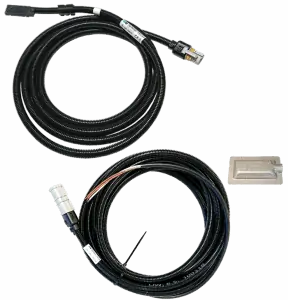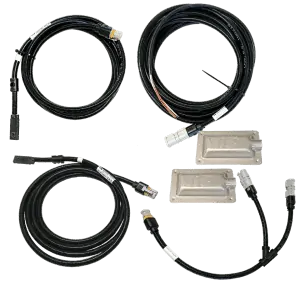SG sensor
 Kimax Accessory
Kimax Accessory

SG sensor CL
P/N 10208 3 m extension cable
P/N 10209 5 m extension cable
P/N 10250 double SG sensor 8 m
extension cable
Stainless steel cover included
Additional you must purchase gluing materials
SG sensor
The SG sensor is a strain gauge based sensor, which transforms the strain of a beam into a measurable current signal.
Axle load sensor
A typical application for the SG sensor is measuring the strain in a front axle of a truck or a bus.
When the SG sensor is connected to the Kimax radio display, the actual axle strain is measured and the axle load can be calculated.
The SG sensor is program-able, through the Sensor Control Unit. You can change slope from positive to negative, you can adjust offset as well as adjust gain of the SG sensor.
How to install
The SG sensor is bonded to the axle in which the strain is to be measured. It is crucial that the bonding to the axle is good. Grease, paint and corrosion protection must be removed before the actual bonding of the SG sensor is carried out directly on the blank steel.
After bonding and test of the functionality of the SG sensor, the sensor has to be sealed and best of all protected by stainless steel cover.
Bonding of the SG sensor can be done with an epoxy glue. We generally recommend using gluing set provided by us
Where to install
Single SG sensors are typically installed on steering front axles for trucks having leaf spring suspension, as well as they are installed on leaf spring suspended trailer axles.
Dual SG sensors are typical installed on spring suspended rear axle systems, by one sensor on the left side spring and one sensor on the right side spring. The two sensors are connected in parallel by an Y-splitter.
Strain measurement
SG sensors use the linear relation between load on an axle and the strain in the axle.

The gain is set by SCU in 6 steps. The output from the unloaded axle is recommended set to 15% of max signal.
Depending on the load of the axle, the top surface will compress
Typical application for the SG sensor is for leave spring suspended front axles. The sensor is sealed and protected by a stainless steel cover.
Steering front axle installation
SG sensor installation on a steering front axle take typically place by use of one SG sensor on the topside of the axle at the vehicles center line. Cable has to be routed safely from axle to chassis beam taking the up and down movements in account.
Rear axle group installation
Size of your truck and type of your rear axle suspension system dictate our recommendation for best SG sensor installation.
- Light 2 axle trucks typical up to 10 Ton, we recommend the SG sensors installed directly on the axle next to the spring support in left and right side
- Standard 2 axle trucks 10 – 18 ton, we recommend the SG sensors installed on either springs or installed on the axle, decision depends on actual type of springs.
- Heavy 3 or 4-axle trucks above 18 ton, we always recommend the SG sensor installed on the springs. Common spring systems is classic parabolic springs or trapeze springs.
Output signal from two SG sensors at a rear axle group are to be connected in parallel adding output current from both sensors together as a common sensor signal. This adding two SG sensor signals together is easily done by a Y-splitter. The double SG sensor kits are a good option for a rear axle installation.
Configuration of SG sensors
Through a Sensor Control Unit (SCU) you can adjust following parameters of the SG sensors:
- Positive or negative slope, positive slope is selected for topside installation on front axles and parabolic springs, negative slope is selected installation on bottom side of parabolic springs or trapeze springs
- OFFSET output signal, output signal is typically set to 15% of output range ( 3mA)
- Reduce GAIN, gain in sensor can be reduced in steps in case your output signal saturate at max output current before max load is reached.
Factory setting for the sensors are positive slope, offset at 3 mA and gain at max.
Explore www.kimax.com ⇒ Support ⇒ "Order by Part Number" for identifying sensor configurations equal to your truck.






